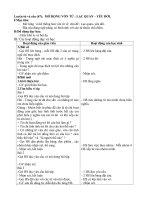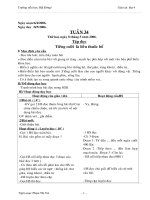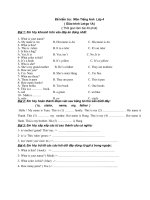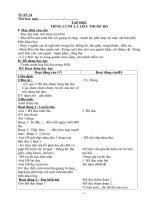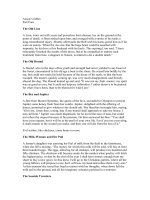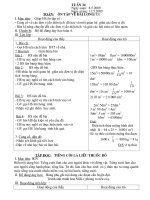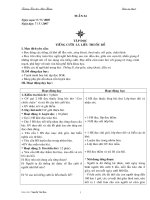English 4- week 34
Bạn đang xem bản rút gọn của tài liệu. Xem và tải ngay bản đầy đủ của tài liệu tại đây (110.96 KB, 9 trang )
<span class='text_page_counter'>(1)</span><div class='page_container' data-page=1>
Week 34 Period 131
Date of planning: 12/5/2017
<b>UNIT 20: WHAT ARE YOU GOING TO DO THIS SUMMER?</b>
<b>Lesson 1: 3-4-5</b>
<b>I. AIMS. </b>
By the end of this lesson, Ps will be able to listen and write specific information
about where someone plans to go.
1. Knowledge:
Sentence patterns: revision
Vocabulary: revision
<b>2. Skills: speaking, listening and reading</b>
3. Attitude: Ps can plan about where someone is going to go.
II. TEACHING METHODS:
- Work in pairs , individual, in groups ….
III. TEACHING AIDS:
<i>1. Teacher’s: student’s and teacher’s book, pictures, cassette.</i>
<i>2. Students’: books, notebooks, workbooks.</i>
<i>3. Class organization:</i>
Class Date of teaching Absent pupils
4A
4B
………
………
IV. PROCEDURE:
Teacher’s activities Pupils’ activities
<b>I. Warm up:(5’)</b>
Spend a few minutes revising the previous lesson. Get
some pairs of ps to the front of the class to practise
Where are you going this summer? I’m going to….
Ps act out the story.
Play the game.
<b>II. New lesson:(30’)</b>
<b>3. Listen and tick.( 11’)</b>
a. Pre-listening:
- T looks at the books and sets the scence:
- Tell the class that they are going to listen to three
conversations about the places the charaters are going
and tick the correct pictures.
- Have ps look at the pictures to identify the three the
places in Viet Nam and say the names aloud.
b. While-listening:
- Play the recording more than once, if necessary. Ask
ps to listen to the recording and tick the correct
pictures. Tell them that they should focus on the
places the characters are going to.
- Get ps to swap their answers befor you check as a
class.
Answer T’s questions
Look at pictures and
answer the questions.
Listen and do the task.
Work individual
</div>
<span class='text_page_counter'>(2)</span><div class='page_container' data-page=2>
Key: 1c 2a 3b
c. Post listening:
- Play a game: Noughts and crosses.
<b>4. Look and write.(11’)</b>
<b>a. Pre- writing:</b>
- Tell ps that they are going to write the answers to
the questions about where they are going, using the
picture cues.
- Give them a few seconds to look at the questions
and answers and to identify the words they need to
complete the answers. Then focus their attention on
the pictures to identify the places..
b. While- writing:
- Give ps time to do the task independently. Go
around and offer help, if necessarry.
- Get them to swap their answers before checking as a
class.
Key: 1. I’m going to Da Nang 2. He’s going to
Hoi An
3. They’re going to Hue.
c. Post- reading:
- Play the game: Whisper
- Guide how to play
<b>5. Let’s sing.(8’)</b>
- Tell ps that they are going to sing the song You are
happy in summer holiday! Teach the song, following
the procedure in Teaching the unit components in
introduction.
- First, have them read each line of the lyrics aloud.
Do choral and individual repetition and check
comprehension. Then play the recording all the way
through. Ask ps to dochoral and individual repetition
of the song line by line.
- When ps are familiar with the tune, ask a pair to the
front of the class. Each of them sings one line of the
song. Then the class sings the song together and claps
<b>hands. </b>
- Work in pairs.
- groups
Play the game.
Look at the book.
Answer T’s questions.
Read words.
Do the task.
Compare their answers in
pairs.
Play the game.
Listen.
Sing in choral and
individually.
Sing in pairs.
<b>III. Consolidation:(3’)</b>
? What’s the content of the lesson? T- Ps
<b>IV. Home-link: (2’)</b>
- Do exercises in the workbook. Learn by heart the
new words and structures.
</div>
<span class='text_page_counter'>(3)</span><div class='page_container' data-page=3>
* Comments:
………
………
……….
Week 34 Period 132
Date of planning: 12/5/2017
<b>UNIT 20: WHAT ARE YOU GOING TO DO THIS SUMMER?</b>
<b>Lesson 2: 1-2-3</b>
<b> I. AIMS. </b>
By the end of this lesson, Ps will be able to ask and answer questions about what
someone plans to do, using What are you going to do? I’m going to…..
1. Knowledge:
Sentence patterns: What are you going to do? I’m going to…..
Vocabulary: stay in a hotel, eat seafood, build sandcastles and go on a boat cruise
<b>2. Skills: speaking, listening and reading</b>
3. Attitude: Ps can talk about what someone plans to do
II. TEACHING METHODS:
- Work in pairs , individual, in groups ….
III. TEACHING AIDS:
<i>1. Teacher’s: student’s and teacher’s book, pictures, cassette.</i>
<i>2. Students’: books, notebooks, workbooks.</i>
<i>3. Class organization:</i>
Class Date of teaching Absent pupils
4A
4B
………
………
IV. PROCEDURE:
Teacher’s activities Pupils’ activities
<b>I. Warm up:(5’)</b>
Spend a few minutes revising the previous lesson.
Call some ps to the front of the class to sing the song
You are happy in summer holidays! The class may
sing the song together and clap hands or do actions.
Groupwork
<b>II. New lesson:(30’)</b>
<b>1. Look, listen and repeat.(8’)</b>
- Tell ps that they are going to find out about how the
characters ask and answer questions about future
plans.
- Ask ps to look at the four pictures to identify the
characters and the context in which the language is
<i>used. Ask them questions such as: Who are they? ?</i>
Look and listen
</div>
<span class='text_page_counter'>(4)</span><div class='page_container' data-page=4>
<i>Where are they?What are they doing?( Linda is in my</i>
<i>room. In picture a, Linda ask Mai what she is doing</i>
<i>and Mai says she is prepairing for her summer</i>
<i>holidays. In picture b, Linda asks Mai Where are you</i>
<i>going? And Mai answers I’m going to Phu Quoc. In</i>
<i>picture c, Linda continues to ask What are you going</i>
<i>to do there? And Mai answers I’m going to swim in</i>
<i>the sea. In picture d, Linda says she likes swimming</i>
<i>too.) Check understanding.</i>
- Play the recording more than once, if necessary, for
ps to listen and repeat the language. Do choral and
individually repetition, pointing to the characters
speaking.
<b>- Play the recording again for Ps to listen and repeat.</b>
<b>2. Point and say.(15)</b>
a. Vocabulary:
<i>- Teach the phrases: stay in a hotel, eat seafood, build</i>
<i>sandcastles and go on a boat cruise. </i>
<i>- Checking: Slap the board</i>
b. Model sentences:
<i>A: What are you going to do? </i>
<i>B: I’m going to swim in the sea.</i>
- Concept check: intonation, using
c. Practice:
- Tell ps that they are going to practise asking and
answering questions abuot future plans.
<b>- Have them look at the bubbles to understand how</b>
the language is used. Then ask them to look at the
pictures to identify what the ps are going to do in the
future.
<i>- Point to the first picture and do the task with one</i>
pupil as a model. Ask ps to saythe question and
answer chorally and individually. Repeat the same
procedure with the rest of the pictures.
- Ask them to practise in pairs one ask and other
answer, using the prompts in the bubbles and picture
cues.
- Call a few pairs to act out the dialogue in front of
the class. Check as a class or correct pronounciation,
if necessary.
<b>3. Let’s talk.(7’)</b>
- Tell Ps that they are going to revise what they have
Listen and repeat in choral
and individual.
Look, listen and repeat in
choral then individual.
Listen and repeat.
T – W – C
H – H
O – P -> C – P
Ps practise asking and
answering.
Ps work in pairs.
Ps work in pairs.
Role play
</div>
<span class='text_page_counter'>(5)</span><div class='page_container' data-page=5>
learnt in L1 and 2, using facts about themselves
- Ask them to work in pairs: one ps asks the questions
and the other gives the answers. Remind them to use
facts about themselves. Go around offering help.
Correct pronunciation, if necessary.
- Call a few pairs to act out their dialogue in front of
<b>the class. </b>
Work in pairs to ask and
asnswer.
Ps act out.
<b>III. Consolidation:(3’)</b>
? What’s the content of the lesson? T- Ps
<b>IV. Home-link: (2’)</b>
- Do exercises in the workbook. Learn by heart the
new words and structures.
Individually
* Comments:
………
………
……….
Week 34 Period 133
Date of planning: 12/5/2017
<b>UNIT 20: WHAT ARE YOU GOING TO DO THIS SUMMER?</b>
<b>Lesson 2: 4-5-6</b>
<b>I. AIMS. </b>
By the end of this lesson, Ps will be able to listen and write specific information
about what someone plans to go and to do.
1. Knowledge:
<b>2. Skills: speaking, listening and reading</b>
3. Attitude: Ps know how to write about what someone plans to go and to do.
II. TEACHING METHODS:
- Work in pairs , individual, in groups ….
III. TEACHING AIDS:
<i>1. Teacher’s: student’s and teacher’s book, pictures, cassette.</i>
<i>2. Students’: books, notebooks, workbooks.</i>
<i>3. Class organization:</i>
Class Date of teaching Absent pupils
4A
4B
………
………
IV. PROCEDURE:
Teacher’s activities Pupils’ activities
<b>I. Warm up:(5’)</b>
Spend a few minutes revising the previous lesson by
playing Spot the odd one out. Follow the procedure in
Games in introduction. You may use the names of the
</div>
<span class='text_page_counter'>(6)</span><div class='page_container' data-page=6>
places and phrases of future plans that ps have learnt
in the previous lesson.
<b>II. New lesson:(30’)</b>
<b> 4. Listen, circle and write.(9’)</b>
a. Pre-listening:
- Ask ps to look at the books and sets the scene
- Tell the class that they are going to listen to four
conversation about Phong and circle the correct
picture.
- First, ask ps to read the sentences to identify the
possible words to fill the gaps. Then have them look
at the pictures and guess what Phong is going to do in
summer. Check understanding.
b. While-listening:
- Play the recording three times for ps to listen and
circle the pictures. Ask them to focus on what Phong
is going to do in summer. Then have them complete
the sentences.
- Get to swap their answers before you check as a
class.
Key: 1a 2b 3a 4a
c. Post listening:
- Play the game: Lucky numbers.
<b>5. Look and write.(9’)</b>
c. Pre - writing:
- Set the scene:
- Tell ps that they are going to write the answers to
the questions What are they going to do?, using the
picture cues.
- First, ask them to look at the incomplete sentences
and identify the mising information they need to fill
in. Then have them look at the pictures to identify
what the ps are going to do. After that, have them find
appropriate phrases to complete the sentences.
b. While- writing:
- Set a time limit for ps to do the task independently.
Go around offering help, if necessary.
- Get them to swap their answers before checking as a
class.
Key: 1. is going to Phu Quoc
2. is going to swim in the sea
3. are going to Sapa
Look at the pictures
Ps answer the T’s
questions.
Listen, circle and write.
Listen and check.
Ps swap.
Play the game.
Look at the pictures.
Listen to the teacher.
Identify the what someone
is doing.
</div>
<span class='text_page_counter'>(7)</span><div class='page_container' data-page=7>
4. are going to play football
<b>c. Post reading:</b>
- Ask Ps to play a game: Whisper
<b>6. Let’s play.(7’)</b>
- Tell ps that they are going to play the game Say
where.
- Put a large may of Viet Nam on the board and
highligh some major cities/ places. Devide the class
into groups of four and ask three groups of ps to stand
in three lines facing the board. AskWhere are you
going this summer holiday? The first os in group1
answer. The first ps in the other two groups have to
find the place on the map and point at it. The quicker
ps wins a point for the group. The groups take turns to
answer the question and the ps who have answered/
pointed should go to the end of the queues. After all
ps have had a go, the group with the most points is
the winner. Then ask another three groups to play the
<b>game. You may ask the winners to play a final. </b>
Play the game.
Listen.
Ps work in groups of three.
Ps work in pairs.
Say the answer.
<b>III. Consolidation:(3’)</b>
? What’s the content of the lesson? T- Ps
<b>IV. Home-link: (2’)</b>
- Do exercises in the workbook. Learn by heart the
new words and structures.
Individually
* Comments:
………
………
……….
Week 34 Period 134
Date of planning: 12/5/2017
<b>UNIT 20: WHAT ARE YOU GOING TO DO THIS SUMMER?</b>
<b>Lesson 3: 1-2-3</b>
<b>I. AIMS. </b>
By the end of this lesson, Ps will be able to pronounce three-syllable words with the
<i>stress on the second syllable: de’licious, e’normous, No’vember, De’cember.</i>
1. Knowledge:
Sentence patterns: revision
Vocabulary: revision
<b>2. Skills: speaking, listening and reading</b>
</div>
<span class='text_page_counter'>(8)</span><div class='page_container' data-page=8>
II. TEACHING METHODS:
- Work in pairs , individual, in groups ….
III. TEACHING AIDS:
<i>1. Teacher’s: student’s and teacher’s book, pictures, cassette.</i>
<i>2. Students’: books, notebooks, workbooks.</i>
<i>3. Class organization:</i>
Class Date of teaching Absent pupils
4A
4B
………
………
IV. PROCEDURE:
Teacher’s activities Pupils’ activities
<b>I. Warm up:(5’)</b>
Spend a few minutes revising the previous lesson by
calling three groups of fourps to the front of the class
to play the game Say where.
Play the game.
<b>II. New lesson:(30’)</b>
<b>1. Listen and repeat.(11’)</b>
- Tell ps that they are going to practise pronouncing
<i>the following words: de’licious, e’normous,</i>
<i>No’vember, De’cember.</i>
<i>- First, have ps look at the words de’licious,</i>
<i>e’normous, No’vember, De’cember in their books.</i>
- Play the recording and ask ps to repeat the words a
few times. Then put the four sentences on the board.
Play the recording more than once, if necessary, and
let ps say the sentences, paying attention to the target
words and stress.
- Do the choral and individual repetition of the words
and sentences until ps feel confident.
- Get some ps to say the sentences, while the rest of
the class claps at the stressed syllables of the target
words. Correct the pronounciation, if necessary.
<b>2. Listen, circle and write. Then say aloud.(11’)</b>
a. Pre-listening:
- Set the scene:
- Tell ps that they are going to listen to the recording
and complete the sentences.
- Give them a few second to read the sentences in
silence and guess the words to fill the gaps of each
sentences. You may ask ps to say the words aloud.
b. While- listening.
- Have ps listen to the recording and circle the
answers. Go around offering help, if necessary.
Listen.
Look the words.
Listen and repeat in
chorus, individually.
Do in choral- individual
Ps perform in front of the
class.
Answer T’s questions.
Listen.
</div>
<span class='text_page_counter'>(9)</span><div class='page_container' data-page=9>
- Have them swap their answers before checking as a
class. Then ask them to read aloud the answers.
Key: 1b 2b 3 a 4a
c. Post-listenning.
- Get Ps to play the game: Slap the board
<b>3. Let’s chant.(8’)</b>
<i>- Tell ps that they are going to say the chant Where</i>
<i>are you going? Follow the procedure in Teaching the</i>
unit components in introduction.
- Have them read the chant and check comprehension.
- Play the recording a few times for ps to do choral
and individual repetition. Show them how to chant
and do actions. Call two groups to give a
demonstration.
- Get groups to sit opposite of each other and practise
chanting and doing actions. Go around offering help,
if necessary.
- Call two groups to the front of the class to chant and
do actions. The rest of the class claps along to the
<b>rhythm. </b>
Ps swap.
Say the sentences aloud.
Play the game.
Listen to the teacher.
Read the chant.
Do choral and individual
repetition.
Work ito groups of four.
Some of groups sing the
chant and do actions.
<b>III. Consolidation:(3’)</b>
? What’s the content of the lesson? T- Ps
<b>IV. Home-link: (2’)</b>
- Do exercises in the workbook. Learn by heart the
new words and structures.
Individually
* Comments:
………
………
……….
</div>
<!--links-->

